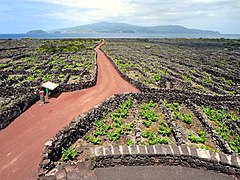Landscape Of The Pico Island Vineyard Culture
The landscape is characterized by an extensive network of long, spaced apart black basalt stone walls that run parallel to the coast and penetrate towards the interior of the island. These walls were erected to protect the vines from the wind and the salty sea spray, which are planted in thousands of small rectangular enclosures locally called currais. Also part of the landscape are the buildings (manor houses, wine cellars, warehouses, conventional houses, and churches), pathways and wells, ports and ramps, that were produced by generations of farmers enabling the production of wine. This landscape has evolved over 500 years and is exceptionally well-preserved and fully authentic in its setting, materials, continued use, function, traditions, techniques, and management systems.
Gallery
-
Typical protective walls and winery's house from basalt stones in the west of the island of Pico
-
Vines planted on basaltic ground near Madalena, Pico Island, Azores.
-
Wines from Pico Island
-
A vinery and the walls around
See also
- Pico IPR, the officially demarcated wine region of Pico.
References
- ^ "Landscape of the Pico Island Vineyard Culture". UNESCO World Heritage Centre. Retrieved 4 July 2021.
- ^ Goulart, Mónica Silva. "Paisagem Vinha da Ilha do Pico". Comissão Nacional da UNESCO (in European Portuguese). Retrieved 4 July 2021.
- ^ "Map of the Landscape of the Pico Island Vineyard Culture". UNESCO. Retrieved 4 July 2021.
- "Secretaria Regional do Ambiente, Landscape of the Pico Island Vineyard Culture". (72 MB)
- UNESCO, Landscape of the Pico Island Vineyard Culture








